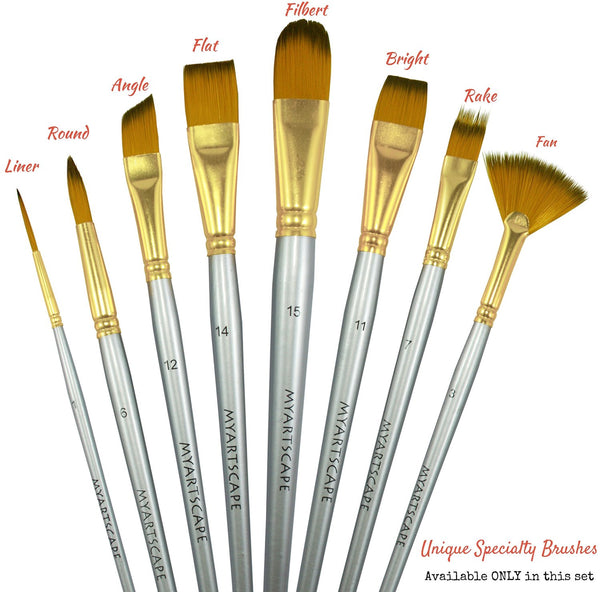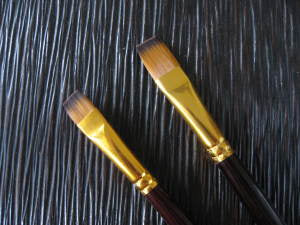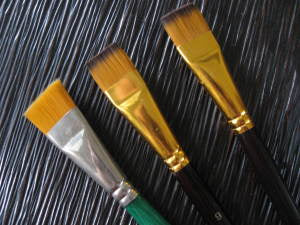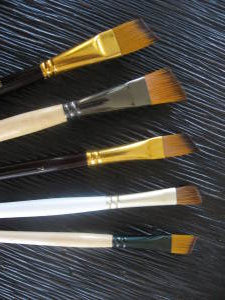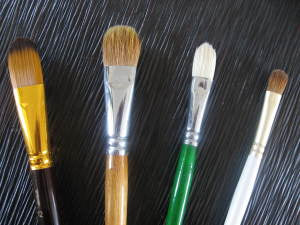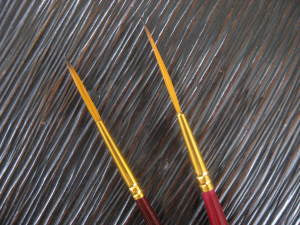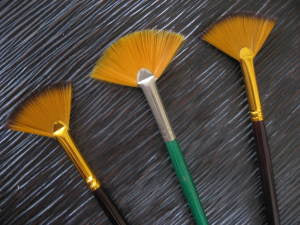Part 2: Selecting the Right Brush Head
In the previous article we covered hair type and which types are best suited to each painting medium. We learned that the finest, most expensive brushes are Kolinsky brushes. While you could use these for heavy duty tasks, such as the under-painting on an oil-painting, the brush would not last very long. Not to mention that it is very difficult to maneuver thick oil paint using such a soft brush.
For this task, it would be much better to use a cheaper hog bristle brush. By the same token, if you try to paint watercolor using the same hog bristle brush, you probably won’t have much success.
As artists we need to learn to match a paint brush to task. Part 1 discussed selecting the best hair – this article is going to focus on how to pick the best head type to achieve the painting effect you are looking for.
Flat
Flat brushes are probably the most common type of paint brush. Generally speaking, the length of the hairs will be twice as long as they are wide.
They are great for blocking in areas and laying down lots of color. They are usually used for acrylics and oils.
Bright
Bright brushes are a special kind of flat brush where the width of the brush is approximately equal to the length of the bristles. The bristles tend to curl inwards at the tip.
This gives better control compared to using a normal flat. They are used for covering large area as well as for blending. They are usually used for oil and acrylic painting.
Wash
Wash brushes can have variable shape but the length of the bristles is very short in relation to the width of the brush.
Wash brushes are useful for broad strokes and laying in lots of color. Generally they are used in watercolor painting.
Angle
As the name implies, the hair filaments are cut at an angle.
This is a versatile brush is useful for precision painting, lines, curves and floating – a technique commonly used with acrylics.
During this process different colors of paint are loaded onto the brush to create a gradation of color.
Filbert
Filberts are awesome for oilsand acrylics. Depending on the way you hold the brush, you can turn them into a round or a flat – this makes them a great multi-functional brush.
The rounded top makes them very well suited to blending, but they can also be used to block in large areas as well as for detailed work during portrait painting.
Round
Rounds are predominantly used for watercolor painting, because the fine point allows for precise work while the body of the brush can still hold plenty of water.
That means that you can paint precisely while still being able to cover large areas.
Rigger / Script liner
These brushes are usually narrow and have very long hairs, which allows them to hold a lot of paint.
They are used to paint fine lines with a constant width, which makes them perfect for lettering, animal whiskers, tree branches and signing your name.
Generally, they are very useful for watercolor painting.
Fan
The fan brush has a bristles spread in an arc by the ferrule.
Commonly this is used forblending, feathering andshading.
They are quite useful for painting detailed objects like trees, branches, grasses or animal hair.
Feathering Shader / Comb
Feathering shaders and comb brushes (sometimes called rakes) aretexturizing brushes which end with natural fingers.
Paint is loaded onto the body of the brush, which is slowly released by the fingers. They are great for cross hatching, water, fur, hair, grasses, wood graining, feathers etc.
What types of brushes do I use?
While I do use all the shapes, the most common ones I use are Flats, Rounds and Filberts. If I had to pick one type for each media, I would pick Rounds for watercolors, Flats for acrylics and Filberts for oils.
You should try to experiment with different brush types and you may just be surprised with the results. Don’t limit your creativity!
Finding the perfect brush can be quite an effort, but is definitely worth the time and expense. Finding a brush that is right for you is a very rewarding experience and enhances the enjoyment you will get from your painting.
Fortunately the MyArtscape brush set covers almost all of these brush types and is constantly under development. I can confidently say that this is one of the most comprehensive synthetic brush sets out there.
Stay tuned for further tips to become a better painter.
Happy Painting :-)



